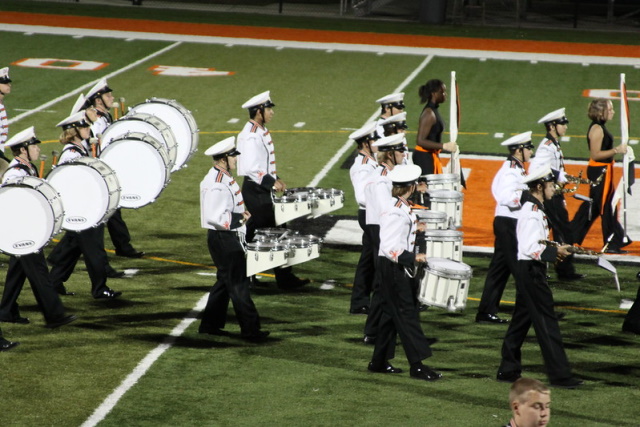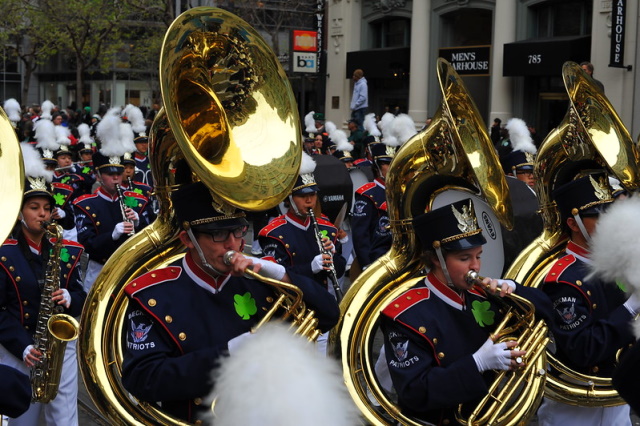Going on a long parade with an instrument comes with several challenges. Different instruments are difficult to march with for various reasons. If your goal is to join a band, knowing which instruments are hardest to march with may help you pick yours.
Band musicians often find the euphonium to be the hardest instrument to march with since it needs to be held far out using only the left arm. Quad drums are also challenging due to their heavy weight and difficult playing technique. Smaller instruments also have their own challenges for marching.
Although the above instruments are commonly regarded as among the hardest to march with, each of the drumline, brass, woodwind, and percussion families of band instruments has its own winner in terms of difficulty for marching. Keep reading for more.
Table of Contents
Challenges of marching with an instrument
Marching for miles in a band requires carrying a potentially bulky and heavy instrument while maintaining balance, performing marching steps and turns, and keeping in sync with the band major and other players, all while playing as accurately as if standing still.
1. Weight
The first and most obvious challenge is weight. Most marching instruments weigh between 15 and 25 pounds, some even more. For example, the tenor drums weigh around 35 pounds, excluding the harness.
Harnesses are made of metal or sometimes fiberglass that weigh around 4 to 8 pounds. The combined weight of the instrument and harness causes strain on your shoulders after a long march parade. Even a slightly heavy instrument like a trumpet becomes stressful to hold after marching for a long time.
2. Balance
Maintaining your balance is another challenge . You have to keep the right posture throughout. The instrument extends out in front of you so you have to brace your body backward. Your body weight also needs to be evenly distributed on your feet, which is hard to achieve when carrying a bulky instrument.
3. Turns
Making quick turns is challenging when carrying a large instrument,. There is some inertia you need to overcome. There are also situations where you are marching down a narrow path with limited moving space – you have to turn in that limited space without hitting other members of your band.
4. Accuracy
Accuracy is another issue. You typically have no musical score in front of you and you’re required to play as though you have one. It is also important that you look at your instrument once in a while marching in order to play the right thing. This is particularly important for tenor drummers who have to hit just a small area of the drum.
5. Coordination
And of course, with so many things to do at once, coordination is a big challenge of marching with an instrument. You need to be precise with the marching routine while playing the instrument accurately. You must also stay alert to see what the band major and other musicians are doing.
Hardest drum instrument to march with

1. Tenor/quad drums
The tenor drums/quads are known for being quite heavy. They are usually the heaviest drum in a drumline and weigh more than most bass drums. Altogether the tenor drums weigh between 35 to 40 pounds- combined with the weight of the harness, it is enough to wreck your back.
The carrying position of the quads makes them even more challenging for the drummer. They stay very far and low from you, and it is important to keep them in place while marching. Besides the awkward carrying position, tenor drums are very difficult to play and require more practice time than other marching percussion.
Unlike the bass drum, with the quads, you have multiple drums in front of you with different sizes and unique sounds, which means more playing techniques to master. You must be well-coordinated while playing from one drum to the next. All the fancy moves must be smooth and well-done.
Marching for a long time with the tenor drums can cause numbness in your whole body. After a while, you no longer feel your feet and can’t even tell if you are marching on time.
2. Bass drums
Bass drums are also difficult to march with for several reasons. Their weight usually ranges from 15 to 25 pounds. They generally weigh less than quads although bigger basses like Bass 5 and 4 tend to be heavier than most quads.
Bass 5 is particularly bulky and very hard for short people. They hang from your shoulders, and you have to hold all the weight with your back. While most people in a band march forward, those marching with a bass drum have to crab step, which is very uncomfortable. Bass 5 drums aren’t as difficult to play as quads though you still have to be precise with the beat.
Hardest brass instrument to march with

1. Euphonium
Of all the brass instruments, the euphonium is likely the hardest to march with. Many people also consider the Euphonium as the most difficult instrument to march with overall. They are very heavy on the hands and are held far from the body.
Although there are different types, most of them weigh between 9 to 11 pounds. This weight might seem small when compared to the quads or bass drum. But unlike those, you don’t get any extra support from a harness while carrying a euphonium. All the carrying force has to come from your arms.
The baritone weighs more than a typical euphonium, and they are by far more difficult to hold between the arms. It cam take years of marching to build the strength needed to support it.
2. Trumpet
Another brass instrument known for being hard to march with is the trumpet. Even though they are not heavy, their lightness makes it difficult to keep sound stable. You have to hold them high up with your arms firm to keep them in place. Doing that for a long time can cause some pain to your arm and forearm.
While trumpets are difficult for being light, sousaphones are difficult for being too heavy and bulky. In terms of weight, they come out on top with around 40 to 50 pounds of weight. The large bell stays above your head and is heavy enough to throw you off balance.
3. Sousaphone
Carrying the sousaphone on one shoulder during long hours of practice can mess up your shoulders by making one higher than the other.
While marching with it, you have to ensure that you maintain the bell angle. You need to hold it in your arms, and it’s important not to rest it on your hip. Otherwise, the bell would start swaying from side to side.
It is even harder when you are taking slide steps. While marching, the bottom of the horn gets very close to hitting your thigh after each step.
4. Trombone
Just like the trumpet, the trombone is another very light instrument many people find hard to march with. It is the lightest brass instrument yet the most awkward of all to march with. It stays horizontally in front of your face with your arms and shoulder as its only support. Moving the slide back and forth while marching requires a lot of coordination.
Hardest percussion instrument to march with
1. Xylophone
The xylophone is one of the heaviest percussion instruments. Over 15 pounds hangs down your shoulder with the aid of a harness. You have to carry all that weight forward with your body while following through with the marching routine.
You have over 10 bars to hit precisely while marching. You need to watch your instrument to know where to hit per time. Before you can get to the point of doing that without looking, many hours of practice are required.
It is even harder to coordinate dance moves and special steps with tuned percussions like the xylophone than it is with the drums or any wind instrument.
2. Cymbals
Playing the cymbals might seem easy, but it isn’t as simple as it looks. Cymbals that are larger than 20 inches are extremely heavy to march with. Both cymbals could weigh as much as a baritone or mellophone and you have to keep that weight at the same angle in both arms.
As a marching cymbalist, you have to maintain perfect control of your grip. You don’t want your cymbals to fall off your hands while marching. Your cymbal visuals must be well-done as wrong moves will be very obvious.
Hardest woodwinds to march with
In the woodwind family, the flute is the lightest instrument. However, even with its small weight, the flute is a hard instrument to march with because of how high you have to hold it.
The angle is also very difficult to maintain – you are required to keep it at that angle the whole time.
You point the flute to the right, and pull your shoulder back throughout the show. Keeping that posture for a long time takes a toll on your arms and shoulder. It takes some time to get used to it.
Note that double reed instruments like the oboe should generally not be marched at all due to both the challenge and the risk their reeds present. See this post for more about marching the oboe.
***
Photo credits:
Featured image: “The Grove City H.S Marching Band” (CC BY 2.0) by Prayitno / Thank you for (12 millions +) view
(2) “DHS Marching Band” (CC BY-SA 2.0) by technochick
(3) “Tubas” (CC BY-SA 2.0) by Chris Hunkeler

